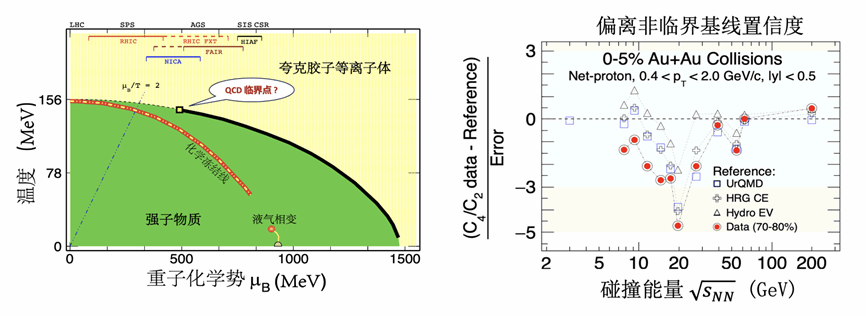HUADA Online News (Reporter Wang Di) Recently, the international authoritative journal Physical Review Letters published the latest research achievement of the Relativistic Heavy Ion Collider (RHIC) STAR collaboration, "High-Precision Measurement of Net-Proton Number Fluctuations in Gold-Gold Collisions at RHIC," as an Editor's Suggestion. The work was also highlighted in Physics, a journal of the American Physical Society.
This research conducted a high-precision measurement of net-proton number fluctuations generated in gold-gold nucleus collisions during the second phase of the RHIC Beam Energy Scan (BES-II), providing key experimental evidence for exploring the critical point in the Quantum Chromodynamics (QCD) phase diagram. Professor Luo Xiaofeng from our university's STAR experiment team is one of the lead authors of this achievement. He collaborated with researchers from the STAR collaboration, including the University of Tsukuba (Japan), Lawrence Berkeley National Laboratory (USA), the National Institute of Science Education and Research (India), the Institute of Modern Physics of the Chinese Academy of Sciences, and the University of Science and Technology of China, to complete this research. The research results were officially published on September 29, 2025. Brookhaven National Laboratory in the USA reported on this achievement promptly, quoting Professor Luo Xiaofeng's comments on the importance of the research.

The search for the QCD critical point is a frontier topic in the field of high-energy nuclear physics. Theoretical predictions suggest that strongly interacting matter undergoes a phase transition from hadronic matter to a new state of matter—the Quark-Gluon Plasma (QGP)—under high temperature and density conditions. Experimental evidence of a critical point or a first-order phase boundary is the necessary and sufficient condition for finally confirming the existence of QGP. Experimentally, event-by-event net-proton number fluctuations are considered an important observable for identifying the QCD phase transition. This work relied on the BES-II experiment at RHIC, utilizing high-statistics data collected by the upgraded STAR detector. It systematically measured the fourth-order cumulant and its ratio of the net-proton number distribution, finding a significant deviation from the non-critical model baseline near a collision energy of 19.6 GeV, with a significance of 2–5 standard deviations. This feature is considered a possible signal of the system entering the QCD critical region. This achievement provides new clues for revealing the evolution and properties of matter under the extreme conditions of the early universe and will lay an important foundation for future exploration of the QCD phase structure and equation of state in the high baryon density region.
Professor Luo Xiaofeng has been leading his team to participate in the RHIC-STAR experiment for over a decade, promoting the development and refinement of net-proton number fluctuation analysis methods, and making core contributions to data analysis, systematic error assessment, and physical interpretation. Dr. Zhang Yu (Guangxi Normal University) and Dr. Huang Yige, trained by the research group, were responsible for the data analysis work for this research result.
It is worth mentioning that during the second phase of the Beam Energy Scan (BES-II), in addition to completing large-scale data collection in collider mode (7.7-19.6 GeV), the STAR experiment also simultaneously conducted fixed-target experiments, covering an even lower collision energy range from 7.7 GeV down to 3 GeV. This significantly expanded the upper limit of the detectable baryon chemical potential from about 420 MeV to about 750 MeV, greatly broadening the exploration range of the high baryon density region in the QCD phase diagram. The published result focuses on high-precision measurements in collider mode; the analysis of fixed-target data is steadily progressing. With the subsequent release of analysis results, it is expected to further enrich the understanding of the QCD critical point and first-order phase transition boundary, and provide more critical experimental evidence for revealing the properties of nuclear matter under extreme conditions.
To gain a leading position and achieve breakthroughs in the research direction of nuclear matter phase structure in the high baryon density region and the search for the QCD critical point—a field with great discovery potential—major technological powers around the world are building large-scale accelerators and particle detectors and conducting heavy-ion collision experiments. These include the Compressed Baryonic Matter (CBM) experiment at FAIR in Germany (trial operation in 2028), the NICA Multi-Purpose Detector (MPD) heavy-ion collision experiment at the Joint Institute for Nuclear Research in Dubna, Russia (trial operation in 2025), and the HIRFL-CSR External-target (CEE) experiment at the Institute of Modern Physics, Chinese Academy of Sciences (trial operation in 2025). Our university has actively joined these experiments and participated in detector development and construction. The research team plans to continue relying on large accelerator facilities at home and abroad to conduct experimental measurements in even lower energy regions (2-8 GeV), to further search for the QCD critical point and confirm its position in the phase diagram.
This work was supported by projects from the National Natural Science Foundation of China and key research and development projects from the Ministry of Science and Technology. RHIC-STAR is a large international collaboration for the STAR experiment located at the Relativistic Heavy Ion Collider at Brookhaven National Laboratory in the United States, consisting of 745 researchers from 76 institutions across 14 countries.
(Reviewed by: Zhao Yunjie)